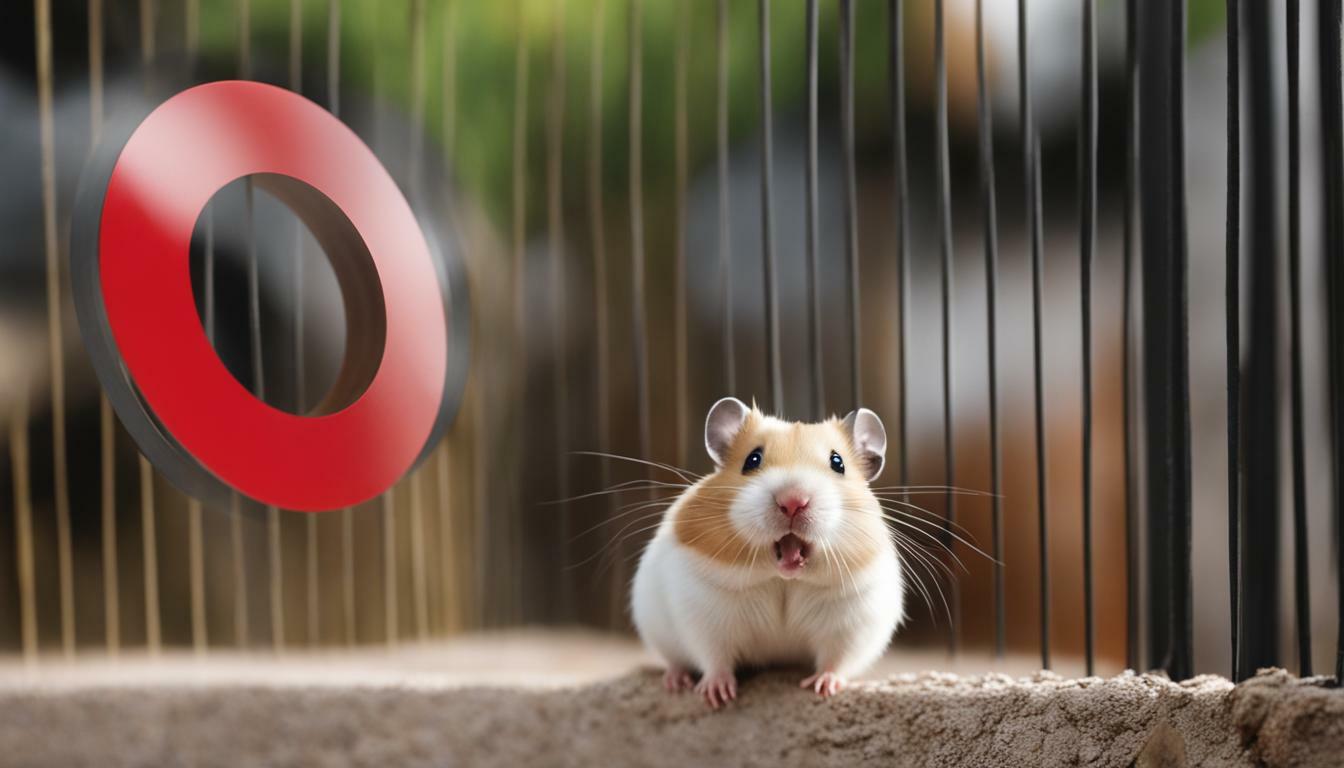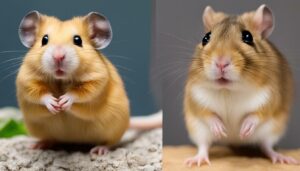If you’re wondering whether hamsters are allowed as pets in Australia, it’s important to know that hamsters are actually illegal to own in the country. The Australian government has strict pet import regulations, and hamsters are specifically prohibited due to biosecurity and biodiversity concerns. While there are exceptions for importing hamsters for research purposes, they are not permitted as pets.
Key Takeaways:
- Hamsters are illegal to own as pets in Australia due to biosecurity and biodiversity concerns.
- Importing hamsters for research purposes may be allowed but is subject to specific regulations.
- Hamsters and gerbils pose a risk to the Australian ecosystem if released or escaped, as they can become pests and compete with native rodents for food resources.
- Reproductive habits of hamsters, with their ability to reach maturity at one month old and produce up to five litters a year, contribute to the potential threat if they were to establish wild populations.
- Allowing hamsters into Australia poses the risk of introducing diseases that could harm native animals and the environment.
Understanding Australia’s Exotic Pet Regulations
Australia has strict regulations in place when it comes to owning exotic pets, and this includes a ban on owning hamsters. The government has implemented these measures to protect the country’s biosecurity and biodiversity. Hamsters and gerbils have the potential to disrupt the delicate balance of Australia’s unique environment, posing a threat to native species and the ecosystem as a whole.
One of the main reasons for the ban is the rapid reproductive habits of hamsters and gerbils. These small rodents reach reproductive maturity at just one month old and can produce up to five litters a year. If released or escaped into the wild, they could quickly establish themselves as pests, competing for food resources with native rodents and potentially causing damage to crops and agriculture.
Additionally, hamsters and gerbils can carry diseases that can be transmitted to native animals. Australia is home to a wide variety of unique and vulnerable species, and introducing new diseases could have devastating consequences for the native wildlife. To prevent this risk, the importation of hamsters as pets is strictly prohibited.
| Pet | Status |
|---|---|
| Hamsters | Banned |
| Gerbils | Banned |
| Other Exotic Pets | Regulated |
It is important to respect and comply with these regulations to protect Australia’s environment, agriculture, and native species. If you are considering getting a pet, there are many legal and widely available options in Australia. From dogs and cats to birds and fish, there are plenty of companions to choose from that won’t pose a risk to the country’s delicate ecosystem.
Biosecurity and Biodiversity Concerns
The ban on hamsters in Australia is primarily driven by concerns regarding biosecurity and protecting the country’s biodiversity. Australia is home to a unique and delicate ecosystem, with a diverse range of native plants and animals. Introducing non-native species, such as hamsters and gerbils, can have significant negative impacts on this fragile environment.
Hamsters and gerbils are known for their ability to reproduce quickly. Hamsters, in particular, reach reproductive maturity at just one month old and can produce up to five litters a year. If these animals were to be released or escape into the wild, their rapid breeding would pose a serious threat to the local rodent populations.
In addition to their reproductive habits, hamsters and gerbils could also compete with native rodents for limited food resources. This competition could disrupt the delicate balance of the Australian ecosystem, potentially leading to the decline of native species.
Protecting Australia’s Environment
Furthermore, the importation of hamsters as pets could introduce diseases that pose a risk to native animals. Australian wildlife has evolved in isolation and may not have the necessary immune defenses against foreign diseases. Allowing hamsters and gerbils into the country could jeopardize the health and well-being of the country’s unique wildlife.
Therefore, in order to protect Australia’s environment, agriculture, and native species, the ban on hamsters is necessary. While it may disappoint some potential pet owners, it is a vital measure to ensure the preservation of the country’s delicate ecosystem. There are, however, many alternative pet options that are legal and widely available in Australia, offering pet lovers a variety of choices while still safeguarding the environment.
| Reasons for Ban on Hamsters in Australia | Implications for the Ecosystem |
|---|---|
| Rapid reproductive habits | Potential decline of native rodent populations |
| Competition for food resources | Disruption of the delicate balance in the ecosystem |
| Risk of introducing diseases | Potential threats to native wildlife |
By implementing strict regulations on the importation of pets, including the ban on hamsters, Australia is prioritizing the protection of its unique environment and biodiversity. These measures are crucial to maintaining the country’s natural beauty and ensuring the long-term survival of its native species.
Reproductive Habits of Hamsters and Gerbils
Hamsters and gerbils have a remarkable ability to reproduce rapidly, with hamsters reaching reproductive maturity at just one month old and producing up to five litters a year. This high fertility rate is one of the reasons why hamsters are not allowed as pets in Australia.
If hamsters were to be released or escaped into the wild, their ability to quickly breed could lead to an overpopulation issue. They would compete with native rodents for food resources, potentially causing a disruption in the ecosystem. This could have detrimental effects on the balance of the Australian environment.
Reproductive Habits Comparison
| Species | Reproductive Maturity | Number of Litters per Year |
|---|---|---|
| Hamsters | 1 month old | Up to 5 litters |
| Gerbils | 3-4 months old | Up to 4 litters |
As seen in the table above, hamsters have a shorter time frame for reaching reproductive maturity compared to gerbils. This, combined with their higher number of litters per year, poses a greater risk if they were to establish themselves in the wild.
The Australian government’s strict regulations aim to protect the country’s environment, agriculture, and native species. By prohibiting the ownership of hamsters as pets, Australia reduces the potential risks that they could pose to the delicate balance of its ecosystems.
Threats to the Australian Ecosystem
The release or escape of hamsters and gerbils into the Australian environment could have detrimental effects on the local ecosystem by competing with native rodents for food resources. These small, prolific breeders are known for their ability to reproduce quickly. Hamsters, in particular, reach reproductive maturity at just one month old and can produce up to five litters a year. If allowed to establish populations in the wild, hamsters and gerbils would pose a significant threat to Australia’s delicate balance of biodiversity.
Native rodents, such as the marsupial mouse and the long-tailed rat, already face challenges in finding enough food to survive. The introduction of hamsters and gerbils would only intensify this competition for resources. These foreign rodents have the potential to outcompete and displace native species, leading to a decline in native rodent populations and disrupting the delicate food chain.
| Threats to the Australian Ecosystem | Impact |
|---|---|
| Competition for food resources with native rodents | Native rodents may struggle to find enough food to survive, leading to a decline in populations. |
| Disruption of the delicate food chain | The introduction of hamsters and gerbils could disrupt the balance of predator-prey relationships and impact other species reliant on native rodents for food. |
| Potential disease transmission | Hamsters and gerbils could introduce diseases to native animals that have not evolved defenses against them, leading to population declines or extinctions. |
Additionally, hamsters and gerbils have the potential to introduce diseases to native animals that have not evolved defenses against them. This could have severe consequences for native wildlife populations, potentially leading to population declines or even extinctions.
In order to protect Australia’s unique environment, agriculture, and native species, the importation of hamsters as pets is strictly prohibited. While it may be disappointing for hamster enthusiasts, these measures are necessary to maintain the delicate ecological balance and preserve the biodiversity that makes Australia so special.
Disease Risks to Native Animals
Allowing hamsters and gerbils as pets in Australia could potentially introduce new diseases that pose a threat to native animals, further emphasizing the need for the ban.
Hamsters and gerbils are known to carry various diseases, some of which can be transmitted to other animals, including native species. These diseases can have devastating effects on the health and well-being of native animals, disrupting fragile ecosystems that have evolved over thousands of years. By preventing the importation and ownership of hamsters and gerbils, Australia aims to protect its unique environment and preserve the delicate balance of its native species.
Diseases Carried by Hamsters and Gerbils
There are several diseases that hamsters and gerbils can carry, making them potential carriers of infection in Australia. One such disease is Lymphocytic Choriomeningitis (LCMV), which can be transmitted to humans and other animals through contact with infected rodents or their saliva, urine, or droppings. LCMV can cause severe illness, including meningitis, and poses a significant risk to public health and the well-being of native species.
Another disease of concern is the Seoul virus, which is carried by certain species of hamsters. This virus can cause hemorrhagic fever with renal syndrome (HFRS) in humans and can be transmitted through direct contact with infected hamsters or exposure to their urine, saliva, or feces. The Seoul virus can have serious health consequences and, if introduced to Australia, could pose a significant threat to both human and animal populations.
| Disease | Transmission | Impact |
|---|---|---|
| Lymphocytic Choriomeningitis (LCMV) | Contact with infected rodents or their bodily fluids | Severe illness, including meningitis |
| Seoul virus | Direct contact with infected hamsters or exposure to their bodily fluids | Hemorrhagic fever with renal syndrome (HFRS) |
Given the potential risks associated with these diseases and the importance of preserving the health and biodiversity of Australia’s environment, it is essential to adhere to the pet import regulations in place and respect the ban on owning hamsters and gerbils as pets. By doing so, we can help protect the well-being of native animals and ensure a sustainable future for Australia’s unique ecosystem.
Alternative Pet Options in Australia
Although hamsters are not allowed as pets in Australia, there are still plenty of other pet options that are both legal and readily available. If you’re looking for a small and low-maintenance pet, consider getting a pet mouse or a pet rat. These rodents have similar characteristics to hamsters and can provide companionship and entertainment.
Another popular choice for a small pet is a guinea pig. Guinea pigs are sociable and enjoy interaction with their owners. They are easy to care for and can be a great addition to any family. Additionally, guinea pigs are legal to own and are not subject to the same import regulations as hamsters.
If you prefer a more adventurous pet, reptiles such as bearded dragons or geckos can be fascinating to observe and care for. These reptiles require specific habitat setups and diets, so make sure to do thorough research and provide the appropriate environment for them.
| Pet Option | Description |
|---|---|
| Pet Mouse | Small, low-maintenance rodent |
| Pet Rat | Sociable and interactive rodent |
| Guinea Pig | Sociable and easy to care for |
| Bearded Dragon | Fascinating reptile with specific care requirements |
| Gecko | Intriguing reptile species |
Remember, when considering a pet, it’s essential to research their specific needs and ensure you can provide a suitable environment for them. Additionally, check with your local authorities and adhere to any pet licensing requirements in your area. By choosing a legal and appropriate pet, you can enjoy the joys of pet ownership while respecting Australia’s environmental regulations.
Exceptions for Research Purposes
While hamsters are prohibited as pets, there are limited circumstances where certain hamsters may be imported for research purposes in Australia. The importation of hamsters for scientific studies is strictly regulated and requires special permits and approvals.
Researchers who wish to import hamsters for research purposes must adhere to strict guidelines set by the Australian government. These guidelines ensure that the importation is necessary for scientific research that benefits the country and that the risks associated with introducing hamsters are minimized.
When applying for an import permit, researchers are required to provide detailed information about their study, including the purpose, methodology, and the number of hamsters needed. They must also demonstrate that the research cannot be conducted using alternative methods or species that are already present in Australia.
| Requirements for Importing Hamsters for Research Purposes | Additional Considerations |
|---|---|
|
|
These strict regulations ensure that any importation of hamsters for research purposes is carried out responsibly and with the utmost care for Australia’s environment and native species. It is important to note that these permits are only granted for specific research projects and do not allow for the general ownership or keeping of hamsters as pets in Australia.
Why Protecting Australia’s Environment is a Priority
Australia places a high priority on protecting its environment, agriculture, and native species, which is why the ban on hamsters is in place. The country’s unique ecosystem is home to a diverse range of plant and animal species found nowhere else in the world. To maintain the delicate balance of this environment, strict regulations are in place to prevent the introduction of non-native species that may pose a threat to the native wildlife and ecosystems.
Hamsters and gerbils, although small in size, have the potential to cause significant harm if they were to be released or escaped into the wild. These rodents reproduce quickly, with hamsters reaching reproductive maturity at just one month old and capable of producing up to five litters a year. This rapid reproductive cycle could lead to a population explosion if hamsters were to establish themselves in the wild, outcompeting native rodents for food resources and disrupting the natural balance of the ecosystem.
In addition to their reproductive habits, hamsters and gerbils also pose a risk of introducing diseases to native animals. Australia’s unique wildlife has evolved in isolation, and the introduction of new diseases can have devastating effects on vulnerable and endemic species. By implementing strict regulations on the importation and ownership of hamsters, the Australian government aims to safeguard the health and well-being of its native fauna.
The Importance of Biosecurity Measures
Biosecurity plays a crucial role in protecting Australia’s environment and agriculture. The introduction of invasive species can have far-reaching consequences, leading to the displacement and extinction of native species, disruption of natural ecosystems, and economic losses for the agricultural sector. Australia’s strict exotic pet regulations, including the ban on hamsters, are part of a comprehensive biosecurity strategy aimed at minimizing the risks and preserving the country’s unique natural heritage.
| Benefits of Protecting Australia’s Environment | Consequences of Not Protecting Australia’s Environment |
|---|---|
|
|
By prioritizing the protection of its environment, Australia aims to ensure the long-term sustainability of its unique ecosystems and the preservation of its native flora and fauna for future generations to enjoy.
Conclusion
In conclusion, hamsters are illegal to own in Australia as they pose a potential threat to the country’s biosecurity, biodiversity, and native species. The importation and ownership of hamsters as pets are strictly prohibited in order to protect Australia’s unique environment and ensure the well-being of its native animals.
Hamsters and gerbils are known for their rapid reproductive habits, with hamsters reaching reproductive maturity at just one month old and producing up to five litters a year. If released or escaped, these prolific breeders could establish themselves in the wild, competing with native rodents for food resources and potentially disrupting the delicate balance of the Australian ecosystem.
Furthermore, the introduction of hamsters and gerbils to Australia could also pose a significant risk to native animals through the potential transmission of diseases. These animals could carry and spread pathogens that threaten the health and survival of Australia’s unique native species.
Therefore, to prioritize the protection of Australia’s environment, agriculture, and native wildlife, hamsters are not permitted to be imported or kept as pets. While hamsters may be allowed for research purposes under certain circumstances, their ownership as household pets is strictly regulated and not allowed.
FAQ
Are hamsters legal in Australia?
No, hamsters are illegal in Australia due to biosecurity and biodiversity concerns.
Why are hamsters illegal in Australia?
Hamsters are not allowed as pets in Australia because they pose a risk to the Australian ecosystem. If released or escaped, they could compete with native rodents for food resources and introduce diseases that threaten native animals.
Can I import hamsters for research purposes?
Certain hamsters can be imported for research purposes, but they are not allowed as pets.
How quickly do hamsters breed?
Hamsters reach reproductive maturity at one month old and can produce up to five litters a year, making them a potential threat if released into the wild.
What are the potential threats of hamsters and gerbils to the Australian ecosystem?
If released or escaped, hamsters and gerbils could compete with native rodents for food resources and introduce diseases that threaten native animals.
Can hamsters and gerbils introduce diseases to native animals?
Yes, hamsters and gerbils have the potential to introduce diseases that could harm native animals if they are allowed into Australia.
What are the alternative pet options in Australia?
There are many legal and widely available pet options in Australia that can be considered as alternatives to hamsters.
Are there any exceptions to the ban on hamsters?
Yes, there are exceptions for the importation of hamsters for research purposes.
Why is protecting Australia’s environment a priority?
Protecting Australia’s environment, agriculture, and native species is a priority to maintain the unique biodiversity of the country.
Are there any restrictions on pet ownership in Australia?
Yes, there are restrictions on pet ownership in Australia to ensure the protection of the environment and native species.




